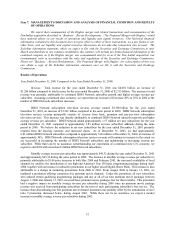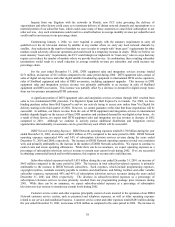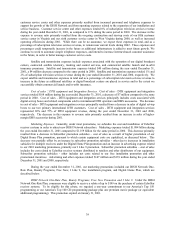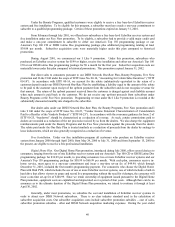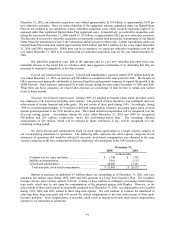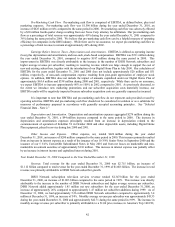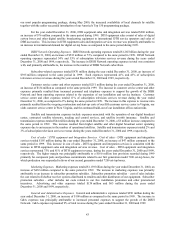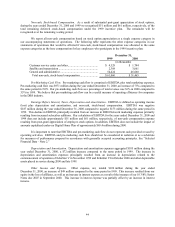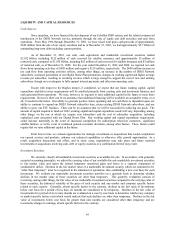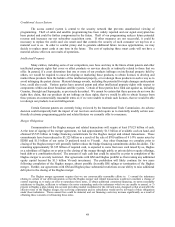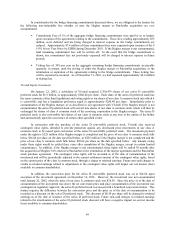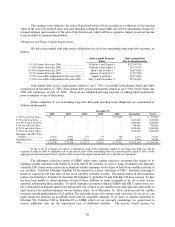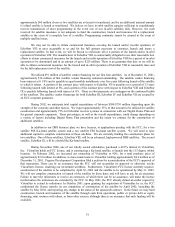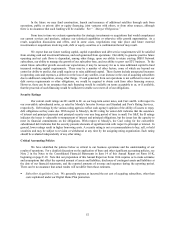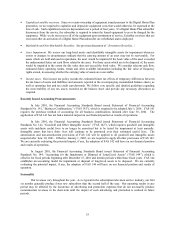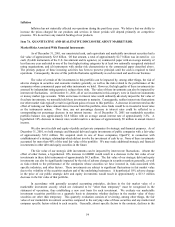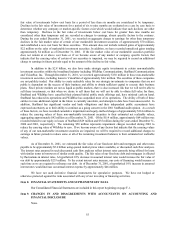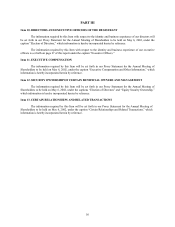Dish Network 2001 Annual Report Download - page 48
Download and view the complete annual report
Please find page 48 of the 2001 Dish Network annual report below. You can navigate through the pages in the report by either clicking on the pages listed below, or by using the keyword search tool below to find specific information within the annual report.46
As of December 31, 2001, we recorded unrealized gains of approximately $4 million as a separate component
of stockholders’ deficit. During the year ended December 31, 2001, we also recorded an aggregate charge to earnings
for other than temporary declines in the fair market value of certain of our marketable investment securities of
approximately $70 million, and established a new cost basis for these securities This amount does not include realized
gains of approximately $22 million on the sales of marketable investment securities. If the fair market value of our
marketable securities portfolio does not remain at or above cost basis or if we become aware of any market or company
specific factors that indicate that the carrying value of certain of our securities is impaired, we may be required to
record additional charges to earnings in future periods equal to the amount of the decline in fair value.
We have made strategic equity investments in certain non-marketable investment securities, which we also
evaluate on a quarterly basis to determine whether the carrying value of each investment is impaired. The securities of
these companies are not publicly traded. As such, this quarterly evaluation consists of reviewing, among other things,
company business plans and current financial statements, if available, for factors which may indicate an impairment in
our investment. Such factors may include, but are not limited to, cash flow concerns, material litigation, violations of
debt covenants and changes in business strategy. Certain of the companies in which we have investments cancelled
their planned initial public offerings and have minimal cash on hand. The ability of certain of these entities to raise
additional capital in the future is currently uncertain, and attempts to date have been unsuccessful. As a result of these
and other factors, during the twelve months ended December 31, 2001, we have recorded cumulative charges to
earnings of approximately $62 million to reduce the carrying values of certain of our non-marketable investment
securities to their estimated fair values. If we become aware of any factors that indicate that the carrying value of
certain of our non-marketable investment securities is impaired, we may be required to record an additional charge to
earnings in future periods.
Deferred Tax Assets
Net deferred tax assets of approximately $69 million and $67 million as of December 31, 2001 and 2000,
respectively, have remained substantially unchanged on our balance sheet since 1996. Additional deferred tax assets
of approximately $844 million generated since 1996 have been substantially offset by adjustments to our valuation
allowance. We expect to generate taxable income in the future, but the timing and amount of that taxable income is
uncertain and we do not believe the criteria for recognition of additional tax benefits are presently satisfied. We
need to generate future taxable income of approximately $190 million to realize the benefit of the net deferred tax
assets recognized and we continue to believe it is more likely than not that the assets we have recorded will be
realized. We expect to adjust the valuation allowance in the future when the timing and amount of additional future
taxable income becomes more certain. If it is determined at some point in the future that any or all of previously
reserved deferred tax assets are more likely than not realizable, significant deferred income tax benefits will need to
be recorded and such benefits may be material.
Internal Revenue Service Proposed Adjustment
During 2001, the Internal Revenue Service conducted an audit of our consolidated federal income tax
returns for the years 1997, 1998, and 1999. As a result of this review, the IRS’ position is that certain subscriber
acquisition costs deducted by us in those years should instead be capitalized and amortized over a period of five
years. We do not agree with this proposed adjustment and have initiated an appeal of the agent’s position. At this
time, the ultimate resolution of this dispute is uncertain. If our arguments for deductibility are unsuccessful and we
are required to capitalize and amortize these costs over five years, the federal net operating losses (“NOLs”)
available to us at December 31, 2001 could be reduced by as much as $1.7 billion. Such an outcome would not
materially alter our ultimate tax obligations but could significantly accelerate the timing of when we would be
required to begin making material current income tax payments. We would also incur a cumulative alternative
minimum tax liability for the years 1998, 2000, and 2001 totaling approximately $7 million. Any reduction in
NOLs and the resulting alternative minimum tax liability would be offset by corresponding deferred tax assets
related to the unamortized capitalized cost and the future credit for the alternative minimum taxes paid which may
be carried forward indefinitely. We intend to vigorously defend our position that we will be able to continue our
current policy of deducting subscriber acquisition costs as incurred for tax purposes. However, as of December 31,
2001, the outcome is uncertain.



